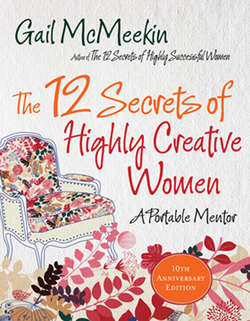Читать книгу The 12 Secrets of Highly Creative Women - Gail McMeekin - Страница 19
На сайте Литреса книга снята с продажи.
Taking Time to Capture Your Ideas
ОглавлениеIf you are out of touch with your inspired self, making a date to connect opens the window. In the wise words of acclaimed writing teacher Brenda Ueland, in her 1938 book, If You Want to Write: A Book About Art, Independence, and Spirit: “Inspiration comes very slowly and quietly. Say that you want to write. Well, not much will come to you the first day. Perhaps nothing at all. You will sit before your typewriter or paper and look out of the window and begin to brush your hair absent-mindedly for an hour or two. Never mind. That is all right. That is as it should be, though you must sit before your typewriter just the same and know, in this dreamy time, that you are going to write, to tell something on paper, sooner or later.
Creativity can be described as letting go of certainties.
—GAIL SHEEHY, WRITER
“And you must also know that you are going to sit here tomorrow for a while, and the next day and so on, forever and ever.”
Research is one sure way to explore your attractions in depth over time. Miriam Nelson was happiest as a child playing outside and doing a variety of sports. She got a pony when she was six years old, skied, swam, and played soccer. Her whole family was very active, but somehow she knew she wanted to be a scientist. As an adult, she merged her two loves of fitness and science by becoming a women's fitness expert. At Tufts University, her research on the benefits of strength training for women and how it slows the aging process as well as promotes health and nutrition is extraordinary. Miriam explains, “I loved science. I was fascinated with discovery and looking through microscopes. Every study that you do, you find out something different than you expected. We always go into a study with clear hypotheses, but we usually find some additional factors that are fascinating as well. I also love working with students—they're so enthusiastic and excited and their energy fires me up. Another benefit is getting to know personally the older people that participate in our studies. A lot of them have become really dear friends.” This affection for her subjects reflects her strong commitment to her investigations and to the promise of longer and healthier lives for women.
Besides noticing your inspirations, you must find a way to capture them. Many creative women keep journals of their insights and ideas. Chronicling your awareness, meandering thoughts and feelings honors their value and signals to you that your creative process deserves attention. Sigrid Olsen keeps a sketchbook of her ideas, including swatches of fabric and color she collects.
Just don't give up trying to do what you really want to do. Where there is love and inspiration, I don't think you can go wrong.
—ELLA FITZGERALD, SINGER
“I might see something in a retail store, in a museum or a magazine, or on a person that sparks an idea and I think, that's an interesting color combination that I haven't put together before. We go to Europe four times a year to see the print and fabric shows and that's a very inspirational trip. And I might say, ‘I love the idea of a black and white group followed by watery cool colors.’ Then we'll do something hot and floral and then switch to something mysterious in spice tones. I'm always looking at the flow of color for all four seasons.”
Renowned chef Lydia Shire, whose career was nurtured by Julia Child and who now owns two famous restaurants in Boston—Biba's and Pignoli's—still creates her own menus with partner Susan Regis. Lydia also deliberately collects her brainstorms: “What I do is read a lot of books and magazines. I do my homework, and something will jog my interest. I keep a kind of a balance in my head all the time. For instance, I'll think, we haven't had a skirt steak on Biba's menu for a long time and I'll say to myself—perhaps for the spring or summer—I don't want to do any more sirloin. Then maybe I'll feel like I want to be in Mexico, so we'll make white corn tamales to accompany the skirt steak or some kind of tomato dish. Or Susan will say, ‘Let's do a capon.’ And I'll say, ‘And let's do it with this kind of marinade,’ and she'll say she was thinking about the same thing. But we have fun—we go to her house or my house—and she brings her homework and I bring mine and we recreate the menu for each season, which is 120 new dishes every year just for Biba's. So I always say that I think what I get paid for is writing these menus.”
Alice Aspen March is an authority on the effects of television viewing on the family as well as the coproducer of the Emmy-nominated documentary Latchkey Kids. As Alice has learned for herself, in order to develop our creativity, we have to give it our full attention: “Time is absolutely vital to the creative process. We have to figure out how to take it and give it to ourselves. Only when we realize the kind of attention we need to be creative, do we realize the value of our time. I don't think any of us learned about this when we were growing up. I know I didn't. No one ever said to me, ‘Alice, this is your time. What would you like to do with it?’ I never saw this role-modeled either. So I have had to learn the process of asking for the time I need to dip into my creative well. And learning that has taken a very long time.”
